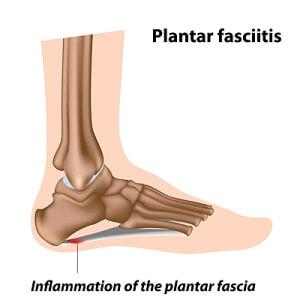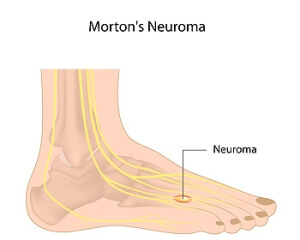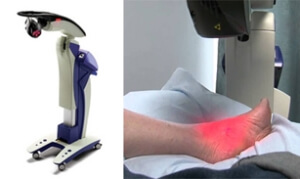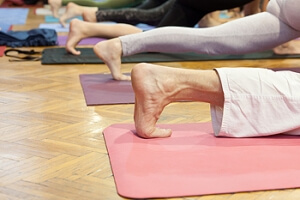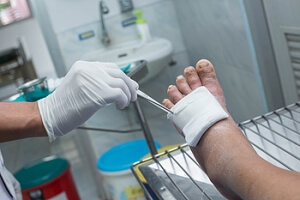Super User
How to Get a Proper Shoe Fit
Many people suffer from foot problems because their shoes are poorly fitted. When shopping for a new pair of shoes, fashion usually triumphs over comfortability. A pair of well fitted shoes is essential in preventing foot problems and potential injuries.
Poorly fitted shoes can cause foot issues such as plantar fasciitis, bunions, hammertoes, ingrown toenails, and foot pain. Shoes such as high heels and sandals may cause problems for your feet. These shoes put the foot in an unnatural position for long periods and fail to provide good foot support. It is recommended to not wear either one for an extended period.
When you are trying on shoes, make sure they have enough space for your toes to move around. Shoes shouldn’t be cramped but also shouldn’t have too much room that your foot moves around in them. A snug shoe is a good choice. They should also provide good arch support and cushioning. Athletic shoes tend to offer both good support and cushioning. A degree of flexibility is necessary so they aren’t too stiff or too unsupportive.
If you can wear your shoes for a long period of time without experiencing any discomfort, this is a sign that your shoes fit properly. Do not be too dismayed if the shoe isn’t a perfect fit at first; many shoes take a few days to weeks to properly break in. However don’t expect an uncomfortable shoe to become fitted to your foot.
For those with foot conditions such as flat feet or pronation, orthotics may be helpful or even necessary to prevent foot pain. Orthotics are inserts that are placed in the shoe and provide support and cushioning for the foot. While there are many types of orthotics out there, custom-made orthotics may be necessary depending upon your foot and foot conditions.
Feet change in size over time. It is important to check your foot size over time so that you can make sure you have the perfect fit for your feet. A podiatrist can provide more information on proper shoe fitting and foot orthotics.
What Can I Do to Prevent Plantar Fasciitis?
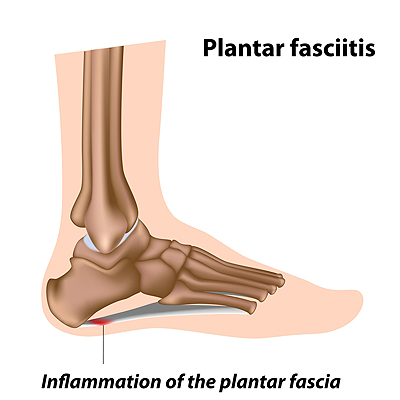 Plantar fasciitis, an inflammation of the ligament that runs along the bottom of the foot, is one of the most common causes of heel pain in adults. This is unsurprising, as the plantar fascia can undergo heavy wear and tear from our daily habits and activities. Some of the things that can put the plantar fascia at an increased risk of injury are wearing poorly-fitted shoes, sudden weight gain which puts increased pressure on the feet, excessive or very intense exercise routines, standing for prolonged periods of time, and abnormalities in the way you walk. There are several things that you can do that may prevent plantar fasciitis. Wearing comfortable, properly-fitted shoes or using orthotic inserts can help support the plantar fascia during walking, standing, and other physical activities. It is also important to rest your feet regularly, which can reduce foot strain. Stretching your feet may help prevent plantar fasciitis as well, as stretching increases your foot’s flexibility and resistance to injury. For more information on what you can do to prevent plantar fasciitis, or to learn about treatment options if you are experiencing foot pain, consult a podiatrist today.
Plantar fasciitis, an inflammation of the ligament that runs along the bottom of the foot, is one of the most common causes of heel pain in adults. This is unsurprising, as the plantar fascia can undergo heavy wear and tear from our daily habits and activities. Some of the things that can put the plantar fascia at an increased risk of injury are wearing poorly-fitted shoes, sudden weight gain which puts increased pressure on the feet, excessive or very intense exercise routines, standing for prolonged periods of time, and abnormalities in the way you walk. There are several things that you can do that may prevent plantar fasciitis. Wearing comfortable, properly-fitted shoes or using orthotic inserts can help support the plantar fascia during walking, standing, and other physical activities. It is also important to rest your feet regularly, which can reduce foot strain. Stretching your feet may help prevent plantar fasciitis as well, as stretching increases your foot’s flexibility and resistance to injury. For more information on what you can do to prevent plantar fasciitis, or to learn about treatment options if you are experiencing foot pain, consult a podiatrist today.
Plantar fasciitis is a common foot condition that is often caused by a strain injury. If you are experiencing heel pain or symptoms of plantar fasciitis, contact one of our podiatrists from New Tampa Foot & Ankle. Our doctors can provide the care you need to keep you pain-free and on your feet.
What Is Plantar Fasciitis?
Plantar fasciitis is one of the most common causes of heel pain. The plantar fascia is a ligament that connects your heel to the front of your foot. When this ligament becomes inflamed, plantar fasciitis is the result. If you have plantar fasciitis you will have a stabbing pain that usually occurs with your first steps in the morning. As the day progresses and you walk around more, this pain will start to disappear, but it will return after long periods of standing or sitting.
What Causes Plantar Fasciitis?
- Excessive running
- Having high arches in your feet
- Other foot issues such as flat feet
- Pregnancy (due to the sudden weight gain)
- Being on your feet very often
There are some risk factors that may make you more likely to develop plantar fasciitis compared to others. The condition most commonly affects adults between the ages of 40 and 60. It also tends to affect people who are obese because the extra pounds result in extra stress being placed on the plantar fascia.
Prevention
- Take good care of your feet – Wear shoes that have good arch support and heel cushioning.
- Maintain a healthy weight
- If you are a runner, alternate running with other sports that won’t cause heel pain
There are a variety of treatment options available for plantar fasciitis along with the pain that accompanies it. Additionally, physical therapy is a very important component in the treatment process. It is important that you meet with your podiatrist to determine which treatment option is best for you.
If you have any questions, please feel free to contact our office located in Wesley Chapel, FL . We offer the newest diagnostic and treatment technologies for all your foot care needs.
Where Is the Pain From Morton’s Neuroma Felt?
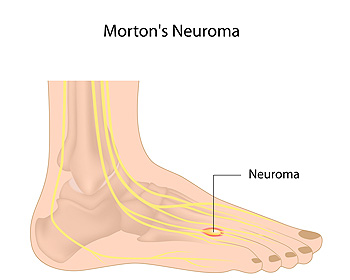 Patients who have pain between the toes may be experiencing a condition that is referred to as Morton’s neuroma. This condition is a result of a compressed nerve and can be caused by wearing shoes that do not fit properly. Additionally, it may occur from participating in sporting activities such as running and dancing. Some patients have a foot structure that can lead to developing this ailment, and existing foot conditions including hammertoes and bunions may contribute to the onset of Morton’s neuroma. The pain and discomfort can range from a tingling to a burning sensation, and can radiate to the ball of the foot. If you have pain in this part of your foot, it is strongly recommended that you schedule a consultation with a podiatrist who can properly diagnose and treat this condition.
Patients who have pain between the toes may be experiencing a condition that is referred to as Morton’s neuroma. This condition is a result of a compressed nerve and can be caused by wearing shoes that do not fit properly. Additionally, it may occur from participating in sporting activities such as running and dancing. Some patients have a foot structure that can lead to developing this ailment, and existing foot conditions including hammertoes and bunions may contribute to the onset of Morton’s neuroma. The pain and discomfort can range from a tingling to a burning sensation, and can radiate to the ball of the foot. If you have pain in this part of your foot, it is strongly recommended that you schedule a consultation with a podiatrist who can properly diagnose and treat this condition.
Morton’s neuroma is a very uncomfortable condition to live with. If you think you have Morton’s neuroma, contact one of our podiatrists of New Tampa Foot & Ankle. Our doctors will attend to all of your foot care needs and answer any of your related questions.
Morton’s Neuroma
Morton's neuroma is a painful foot condition that commonly affects the areas between the second and third or third and fourth toe, although other areas of the foot are also susceptible. Morton’s neuroma is caused by an inflamed nerve in the foot that is being squeezed and aggravated by surrounding bones.
What Increases the Chances of Having Morton’s Neuroma?
- Ill-fitting high heels or shoes that add pressure to the toe or foot
- Jogging, running or any sport that involves constant impact to the foot
- Flat feet, bunions, and any other foot deformities
Morton’s neuroma is a very treatable condition. Orthotics and shoe inserts can often be used to alleviate the pain on the forefront of the feet. In more severe cases, corticosteroids can also be prescribed. In order to figure out the best treatment for your neuroma, it’s recommended to seek the care of a podiatrist who can diagnose your condition and provide different treatment options.
If you have any questions, please feel free to contact our office located in Wesley Chapel, FL . We offer the newest diagnostic and treatment technologies for all your foot care needs.
What is Morton's Neuroma?
Morton’s neuroma, (also referred to as Morton’s metatarsalgia, Morton’s neuralgia, plantar neuroma or intermetatarsal neuroma) is a condition that is caused when the tissue around one of the nerves between your toes begins to thicken. This thickening can result in pain in the ball of the foot. Fortunately, the condition itself is not cancerous.
Morton’s neuroma affects women more often than men with a ratio of 4:1. It tends to target women between the age of 50 and 60, but it can occur in people of all ages. There are some risk factors that may put you at a slightly higher risk of developing the condition. People who often wear narrow or high-heeled shoes are often found to be linked to Morton’s neuroma. Additionally, activities such as running or jogging can put an enormous amount of pressure on the ligament and cause the nerve to thicken.
There usually aren’t any outward symptoms of this condition. A person who has Morton’s neuroma may feel as if they are standing on a pebble in their shoe. They may also feel a tingling or numbness in the toes as well as a burning pain in the ball of their foot that may radiate to their toes.
In order to properly diagnose you, the doctor will press on your foot to feel for a mass or tender spot. He may also do a series of tests such as x-rays, an ultrasound, or an MRI. X-rays are usually done to rule out any other causes for your foot pain such as a stress fracture. Ultrasounds are used to reveal soft tissue abnormalities that may exist, such as neuromas. Your podiatrist may want to use an MRI in order to visualize your soft tissues.
There are three main options for treatment of Morton’s neuroma: Injections, decompression surgery, and removal of the nerve. Injections of steroids into the painful area have been proven to help those with Morton’s neuroma. Decompression surgery has been shown to relieve pressure on the affected nerve by cutting nearby structures such as the ligaments in the foot. Another treatment option would be to surgically remove the growth to provide pain relief.
If you suspect that you have Morton’s neuroma you should make an appointment with your podiatrist right away. You shouldn’t ignore any foot pain that lasts longer than a few days, especially if the pain does not improve.
Causes and Symptoms of Cuboid Syndrome
 Cuboid syndrome can occur when the cuboid bone, located at the center of the foot, dislocates. While cuboid syndrome is common in athletes and dancers, there are many common causes of this ailment, and it can affect anyone. Situations such as overuse, ankle sprains, pronated or inward-turned feet, sports with side to side movement, training on uneven surfaces, or poorly fitted shoes can all lead to the cuboid bone becoming dislodged. Some symptoms of cuboid syndrome may include a sharp pain on the side of the little toe, difficulty walking, worsening pain when pushing off, and a reduced range of motion in the foot. If you believe that you are experiencing cuboid syndrome, it is important to consult with a podiatrist for proper treatment and care.
Cuboid syndrome can occur when the cuboid bone, located at the center of the foot, dislocates. While cuboid syndrome is common in athletes and dancers, there are many common causes of this ailment, and it can affect anyone. Situations such as overuse, ankle sprains, pronated or inward-turned feet, sports with side to side movement, training on uneven surfaces, or poorly fitted shoes can all lead to the cuboid bone becoming dislodged. Some symptoms of cuboid syndrome may include a sharp pain on the side of the little toe, difficulty walking, worsening pain when pushing off, and a reduced range of motion in the foot. If you believe that you are experiencing cuboid syndrome, it is important to consult with a podiatrist for proper treatment and care.
Cuboid syndrome, also known as cuboid subluxation, occurs when the joints and ligaments near the cuboid bone in the foot become torn. If you have cuboid syndrome, consult with one of our podiatrists from New Tampa Foot & Ankle. Our doctors will assess your condition and provide you with quality foot and ankle treatment.
Cuboid syndrome is a common cause of lateral foot pain, which is pain on the outside of the foot. The condition may happen suddenly due to an ankle sprain, or it may develop slowly overtime from repetitive tension through the bone and surrounding structures.
Causes
The most common causes of cuboid syndrome include:
- Injury – The most common cause of this ailment is an ankle sprain.
- Repetitive Strain – Tension placed through the peroneus longus muscle from repetitive activities such as jumping and running may cause excessive traction on the bone causing it to sublux.
- Altered Foot Biomechanics – Most people suffering from cuboid subluxation have flat feet.
Symptoms
A common symptom of cuboid syndrome is pain along the outside of the foot which can be felt in the ankle and toes. This pain may create walking difficulties and may cause those with the condition to walk with a limp.
Diagnosis
Diagnosis of cuboid syndrome is often difficult, and it is often misdiagnosed. X-rays, MRIs and CT scans often fail to properly show the cuboid subluxation. Although there isn’t a specific test used to diagnose cuboid syndrome, your podiatrist will usually check if pain is felt while pressing firmly on the cuboid bone of your foot.
Treatment
Just as the range of causes varies widely, so do treatments. Some more common treatments are ice therapy, rest, exercise, taping, and orthotics.
If you have any questions, please feel free to contact our office located in Wesley Chapel, FL . We offer the newest diagnostic and treatment technologies for all your foot care needs.
Cuboid Syndrome
Cuboid syndrome mostly affects athletes, although it can affect non-athletes too. It is also known as cuboid subluxation or cuboid fault syndrome. This condition occurs when joints and ligaments near the cuboid bone of the foot are damaged, or when the cuboid bone itself is dislodged from its natural position. It is usually marked by pain on the outer side of the foot, which may be persistent or may come and go. Cuboid syndrome can be difficult to diagnose unless it becomes severe and more noticeable. Your doctor will likely ask questions about when the pain began and how long it has been present, and will put pressure on the cuboid bone to determine if that area is the origin of the pain.
Causes of Cuboid Syndrome
- Any repetitive stresses placed on the foot due to athletic activities are a common cause of cuboid syndrome.
- Although it develops over time, it is possible that this syndrome can occur all of sudden due to a single event or injury.
- Over-pronation can exacerbate the condition if not corrected.
Disagreements Amongst Podiatrists Regarding Cuboid Syndrome
- Some refer to it as the dislocation of the calcaneal-cuboid joint only.
- Other podiatrists see it as an injury of the ligaments located nearby, which also involves the cuboid bone.
It is very important that when you experience any kind of pain on the side of your foot, you should seek medical care right away. If a subluxed cuboid is caught early, your feet may respond well to the treatment, and you can get back into sports or other activities again as soon as the pain subsides.
What is MLS Laser Therapy?
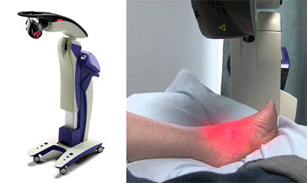 Multiwave Locked System (MLS) Laser Therapy is a laser treatment that uses a combination of wavelengths of light to reduce pain, swelling and inflammation in various parts of the body. MLS Laser Therapy can be used to treat many conditions, including arthritis and arthritic joint pain, Achilles tendon injuries, plantar fasciitis, fractures, gout, and peripheral neuropathy. MLS Laser Therapy treatment is safe, painless, and noninvasive. For some conditions, it may be used as an alternative to prescription medications and surgeries. If you are interested in exploring MLS Laser Therapy as a potential treatment option, please consult with your podiatrist.
Multiwave Locked System (MLS) Laser Therapy is a laser treatment that uses a combination of wavelengths of light to reduce pain, swelling and inflammation in various parts of the body. MLS Laser Therapy can be used to treat many conditions, including arthritis and arthritic joint pain, Achilles tendon injuries, plantar fasciitis, fractures, gout, and peripheral neuropathy. MLS Laser Therapy treatment is safe, painless, and noninvasive. For some conditions, it may be used as an alternative to prescription medications and surgeries. If you are interested in exploring MLS Laser Therapy as a potential treatment option, please consult with your podiatrist.
MLS Laser Therapy is a successful alternative for treating any pain you may be experiencing related to certain podiatric conditions. If you are interested in MLS Laser Therapy, consult with one of our podiatrists from New Tampa Foot & Ankle. Our doctors will assess your condition and provide you with quality foot and ankle treatment.
MLS Laser Therapy
Multiwave Locked System (MLS) Laser Therapy is a patented, FDA-cleared technology that helps relieve pain and inflammation from a number of podiatric conditions, including:
- Heel Pain
- Plantar Fasciitis
- Sports Injuries
- Wounds
- Achilles Tendonitis
- Arthritis
- Neuropathy
- Neuromas
MLS Laser Therapy is an ideal alternative to surgery and prescription medication, as it has no negative side effects and encourages accelerated healing. Among its many clinical benefits, MLS Laser Therapy also:
- Reduces swelling due to bruising or inflammation
- Blocks pain
- Reduces formation of scar tissue
- Improves nerve function
If you have any questions, please feel free to contact our office located in Wesley Chapel, FL . We offer the newest diagnostic and treatment technologies for all your foot care needs.
Foot Stretches May Prevent Muscle Cramps
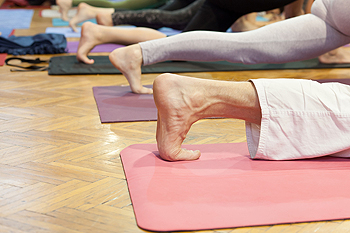 There are specific stretches that can be performed which can benefit the feet and ankles. Calf stretches are helpful in stretching the Achilles tendon, which is located at the back of the leg. Its purpose is to connect the heel to the calf muscles, and stretching this tendon will help to keep it flexible. This can be accomplished by standing on a step, and gently lowering one heel at a time. The top of the foot can be strengthened by picking up marbles with the toes, and slowly releasing them. Performing a towel pull is an effective stretch to keep the overall foot strong. This is done by sitting down with your legs in front of you, putting a towel across the bottom of your feet, and pulling it toward you. When the proper foot stretches are frequently practiced, muscle cramps may possibly be prevented. If you would like additional information about stretching exercises for the feet, please consult with a podiatrist.
There are specific stretches that can be performed which can benefit the feet and ankles. Calf stretches are helpful in stretching the Achilles tendon, which is located at the back of the leg. Its purpose is to connect the heel to the calf muscles, and stretching this tendon will help to keep it flexible. This can be accomplished by standing on a step, and gently lowering one heel at a time. The top of the foot can be strengthened by picking up marbles with the toes, and slowly releasing them. Performing a towel pull is an effective stretch to keep the overall foot strong. This is done by sitting down with your legs in front of you, putting a towel across the bottom of your feet, and pulling it toward you. When the proper foot stretches are frequently practiced, muscle cramps may possibly be prevented. If you would like additional information about stretching exercises for the feet, please consult with a podiatrist.
Stretching the feet is a great way to prevent injuries. If you have any concerns with your feet consult with one of our podiatrists from New Tampa Foot & Ankle. Our doctors will assess your condition and provide you with quality foot and ankle treatment.
Stretching the Feet
Stretching the muscles in the foot is an important part in any physical activity. Feet that are tight can lead to less flexibility and make you more prone to injury. One of the most common forms of foot pain, plantar fasciitis, can be stretched out to help ease the pain. Stretching can not only ease pain from plantar fasciitis but also prevent it as well. However, it is important to see a podiatrist first if stretching is right for you. Podiatrists can also recommend other ways to stretch your feet. Once you know whether stretching is right for you, here are some excellent stretches you can do.
- Using a foam roller or any cylindrical object (a water bottle or soda can will do), roll the object under your foot back and forth. You should also exert pressure on the object. Be sure to do this to both feet for a minute. Do this exercise three times each.
- Similar to the previous one, take a ball, such as a tennis ball, and roll it under your foot while seated and exert pressure on it.
- Grab a resistance band or towel and take a seat. If you are using a towel, fold it length wise. Next put either one between the ball of your foot and heel and pull with both hands on each side towards you. Hold this for 15 seconds and then switch feet. Do this three times for each foot.
- Finally hold your big toe while crossing one leg over the other. Pull the toe towards you and hold for 15 seconds. Once again do this three times per foot.
It is best to go easy when first stretching your foot and work your way up. If your foot starts hurting, stop exercising and ice and rest the foot. It is advised to then see a podiatrist for help.
If you have any questions, please feel free to contact our office located in Wesley Chapel, FL . We offer the newest diagnostic and treatment technologies for all your foot care needs.
Diabetes and Foot Wounds
 Diabetes is a common ailment among many patients. If there is a wound on the foot, it is suggested that correct treatment begins as quickly as possible in order to help prevent foot ulcers from developing. This painful condition may occur as a result of neuropathy, which can cause the inability to feel if there are existing cuts, scrapes or bruises on the feet. Diabetic patients are urged to take proper care of their feet. This can consist of washing and drying the feet thoroughly, and it can be beneficial to apply a good moisturizer. Additionally, it is important to trim the toenails correctly, and wear shoes that fit properly. If you have diabetes, it is strongly advised that you are under the care of a podiatrist who can offer management techniques that are right for you.
Diabetes is a common ailment among many patients. If there is a wound on the foot, it is suggested that correct treatment begins as quickly as possible in order to help prevent foot ulcers from developing. This painful condition may occur as a result of neuropathy, which can cause the inability to feel if there are existing cuts, scrapes or bruises on the feet. Diabetic patients are urged to take proper care of their feet. This can consist of washing and drying the feet thoroughly, and it can be beneficial to apply a good moisturizer. Additionally, it is important to trim the toenails correctly, and wear shoes that fit properly. If you have diabetes, it is strongly advised that you are under the care of a podiatrist who can offer management techniques that are right for you.
Diabetic foot care is important in preventing foot ailments such as ulcers. If you are suffering from diabetes or have any other concerns about your feet, contact one of our podiatrists from New Tampa Foot & Ankle. Our doctors can provide the care you need to keep you pain-free and on your feet.
Diabetic Foot Care
Diabetes affects millions of people every year. The condition can damage blood vessels in many parts of the body, especially the feet. Because of this, taking care of your feet is essential if you have diabetes, and having a podiatrist help monitor your foot health is highly recommended.
The Importance of Caring for Your Feet
- Routinely inspect your feet for bruises or sores.
- Wear socks that fit your feet comfortably.
- Wear comfortable shoes that provide adequate support.
Patients with diabetes should have their doctor monitor their blood levels, as blood sugar levels play such a huge role in diabetic care. Monitoring these levels on a regular basis is highly advised.
It is always best to inform your healthcare professional of any concerns you may have regarding your feet, especially for diabetic patients. Early treatment and routine foot examinations are keys to maintaining proper health, especially because severe complications can arise if proper treatment is not applied.
If you have any questions please feel free to contact our office located in Wesley Chapel, FL . We offer the newest diagnostic and treatment technologies for all your foot and ankle needs.
Diabetic Foot Care
Diabetes can cause two problems that can potentially affect the feet: Diabetic neuropathy and Peripheral Vascular Disease. Diabetic neuropathy occurs when nerves in your legs and feet become damaged, which prevents you from feeling heat, cold, or pain. The problem with diabetic neuropathy is that a cut or sore on the foot may go unnoticed and the cut may eventually become infected. This condition is also a main cause of foot ulcers. Additionally, Peripheral vascular disease also affects blood flow in the body. Poor blood flow will cause sores and cuts to take longer to heal. Infections that don’t heal do to poor blood flow can potentially cause ulcers or gangrene.
There are certain foot problems that are more commonly found in people with diabetes such as Athlete’s foot, calluses, corns, blisters, bunions, foot ulcers, ingrown toenails, and plantar warts. These conditions can lead to infection and serious complications such as amputation. Fortunately, proper foot care can help prevent these foot problems before they progress into more serious complications.
Each day you should wash your feet in warm water with a mild soap. When you finish washing your feet, dry them carefully especially between your toes. You should also perform daily foot inspections to ensure you don’t have any redness, blisters, or calluses. Furthermore, if you are diabetic, you should always wear closed-toed shoes or slippers to protect your feet. Practicing these tips will help ensure that your feet are kept healthy and away from infection.
If you have diabetes, contact your podiatrist if you have any of the following symptoms on your feet: changes in skin color, corns or calluses, open sores that are slow to heal, unusual and persistent odor, or changes in skin temperature. Your podiatrist will do a thorough examination of your feet to help treat these problematic conditions.
